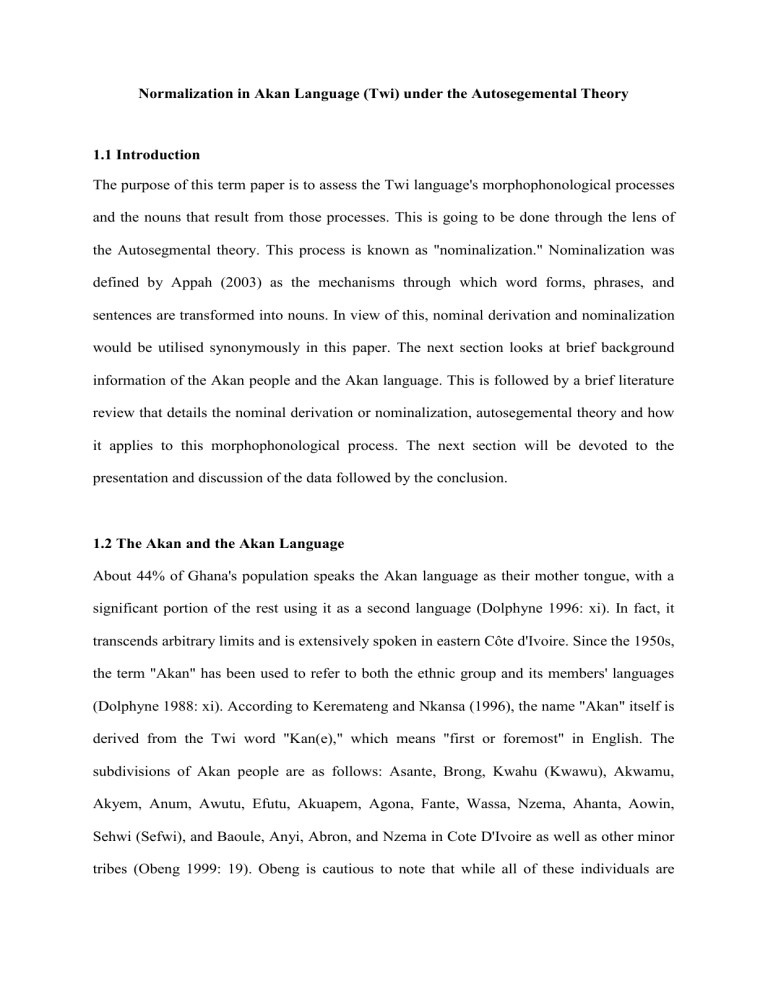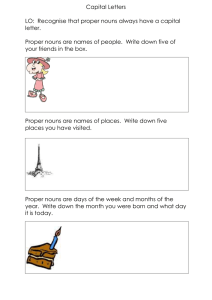
Normalization in Akan Language (Twi) under the Autosegemental Theory 1.1 Introduction The purpose of this term paper is to assess the Twi language's morphophonological processes and the nouns that result from those processes. This is going to be done through the lens of the Autosegmental theory. This process is known as "nominalization." Nominalization was defined by Appah (2003) as the mechanisms through which word forms, phrases, and sentences are transformed into nouns. In view of this, nominal derivation and nominalization would be utilised synonymously in this paper. The next section looks at brief background information of the Akan people and the Akan language. This is followed by a brief literature review that details the nominal derivation or nominalization, autosegemental theory and how it applies to this morphophonological process. The next section will be devoted to the presentation and discussion of the data followed by the conclusion. 1.2 The Akan and the Akan Language About 44% of Ghana's population speaks the Akan language as their mother tongue, with a significant portion of the rest using it as a second language (Dolphyne 1996: xi). In fact, it transcends arbitrary limits and is extensively spoken in eastern Côte d'Ivoire. Since the 1950s, the term "Akan" has been used to refer to both the ethnic group and its members' languages (Dolphyne 1988: xi). According to Keremateng and Nkansa (1996), the name "Akan" itself is derived from the Twi word "Kan(e)," which means "first or foremost" in English. The subdivisions of Akan people are as follows: Asante, Brong, Kwahu (Kwawu), Akwamu, Akyem, Anum, Awutu, Efutu, Akuapem, Agona, Fante, Wassa, Nzema, Ahanta, Aowin, Sehwi (Sefwi), and Baoule, Anyi, Abron, and Nzema in Cote D'Ivoire as well as other minor tribes (Obeng 1999: 19). Obeng is cautious to note that while all of these individuals are Akans, that is, they are members of the Akan ethnic group, not all of them speak Akan (20). For instance, the Awutu, Efutu, and Anum speak Guan, whereas the Nsema speak Nzema. As a result, it has been proposed and is widely believed that speakers of Akan dialects only make up a small portion of the Akan population in general. Akuapem, Asante, and Fante are three Akan languages that have achieved literary importance (Dolphyne 1988: xi). It can be challenging for an Asante person, for instance, to comprehend a book in Fante and vice versa, despite the fact that all of the Akan dialects are essentially fundamentally understandable (Obeng 20). Through coordinated efforts of the Language Teaching Centre and Linguistics Department of the University of Ghana at Legon and the Akan Language Committee of the Bureau of Ghanaian Languages, a unified standard orthography has been developed to address this problematic situation (20). Asante and Akuapem speech is referred to as "Twi" (i.e. Asante Twi, Akuapem Twi), despite the fact that the name "Akan" serves as a general term for all Akan language dialects. Akan dialects other than Twi can be distinguished by the subgroups to which they belong. Additionally, it should be noted that while some standard languages are really spoken, Standard Akan is not. One's background is actually pretty obvious based on enunciation and tone variations. For the purposes of this paper, I will concentrate on the Asante Twi using examples from it to analyse the language's morphophonological processes and the nouns that result from those processes under the umbrella of the autosegemental theory. 2.0 Literature Review 2.1 The Autosegemental Theory Autosegmental Phonology is a framework of phonological analysis proposed by John Goldsmith in his PHD thesis in 1976. As a theory of phonological representation, Autosegmental Phonology developed a formal account of ideas that had been sketched in earlier work by several American linguists in decade of 1940 presented a fair amount of discussion regarding suprasegmental, with contribution by, among others, Block,Firth, Harris, Haugen,Smith and Wells . All begin with the initial assumption spelled out clearly, for example, in Harris (1944) and Block (1948) that logically the first procedure in linguistic analysis is to "Slice" the linguistic signal vertically into a number of pieces or can be called Segments . Care must be taken ,of course, to make sure that the signal is sliced finely enough to find the truly minimal units of utterance. Once this process of " Segmentation" has been Completed, the formal representation of a signal Sliced into Segments is a linear Sequence of elements ( Goldsmith,1976:5). The Segmental approach is seen as a set of representation which consist of a linear arrangement of segments (or unordered set of features) and boundaries that are dependent on morphological and syntactic criteria . By contrast, the autosegmental phonology sees phonology as comprising of several tiers , each tier consisting of a linear arrangement of elements; these are linked to each other by association lines which indicate how they are to be coarticulated. (Crystal, 2008:45-46) . Non linear theories claim to give solution to the problems of sound pattern of English especially it`s linear representation of phonology. Linear representation can be used to deal with many phonological rules but it is less appropriate to be used with suprasegmental . These non linear theories are considered the most developed theories of phonology now a days ( Folly,1970:57) . 2.1.1 Principles of Autosegmental Theory Goldsmith states that a theory as autosegmental can be judged according to three criteria: a) The theory should be able to describe any phenomena in the language that the standard theory cannot. b) The theory must present constraint on the acceptable representation. c) The theory must provide constraints on the possible tonlogical rule in the language. The following points (Contour tones, parallel tiers, tone stability) are all considered problems on the standard theory (Generative phonology), and at the same time they are points in favour of Autosegmental theory. Autosegmental phonology was initially developed in response to the challenge of developing an adequate theory of tone. Its immediate source of inspiration was the work of Williams 1971 and Leben 1973; these were the first to introduce non-linear structures into generative phonology in their treatments of tone systems in West African languages such as Margi, Igbo and Mende. In the model proposed by these writers, underlying tones were represented on separate tiers from the feature matrices representing vowels and consonants; they were subsequently merged with these matrices by Tone Mapping Rules that applied in the course of derivation, creating single-tiered representations in surface structure. The principal innovation of autosegmental phonology, as presented in Goldsmith 1976, was the idea that tone mapping rules do not merge tonal and segmental representations, but associate their elements by means of formal entities known as Association Lines. In this framework, phonological representations consist of parallel tiers of phonological segments, both tonal and segmental (Stein & Mcgary, 1992). Tonal Representation t t t H H= high tone L L=low tone t H L t= any tone-bearing unit (vowels or syllables) Elements of each tier, called AUTOSEGMENTALS, are sequentially ordered; elements of adjacent tiers are simultaneous if and only if they are linked by association lines. In this model, all tiers remain independent throughout derivations: at no point is the tonal tier merged with segmental tier. 2.2 Nominalization The term nominalization has been defined in a number of different ways in the literature. It was a term used in traditional Generative Grammar to describe the development of a noun phrase from a subordinate sentence, such as our arrival here from we came here (Crystal 1991). However, in more recent times, it has come to be used to describe how nouns are derived from other word classes, namely adjectives and verbs (Appah, 2003). The definitions that follow will help to further explain the idea. According to Chomsky (1970), nominalization is the act of creating a noun from another word class. An example of this is red +ness becoming redness. The process of nominalization involves creating nouns from verbs and adjectives. e.g. zo – ‘run’, zoou/zoobu – ‘the act of running’, faa – ‘bad’, faalong – ‘bad deed/evil’(Bodomo1997:217). Nominalization is the process or result of forming nouns from some other part of speech by the use of an appropriate derivational affix e.g. green + ness – greenness, odd + ity – oddity, (Crystal 1991). Nominalizations are those that derivational processes which produce nouns from verbs or adjectives (Fabregas & Scalise, 2012). Nominalization is the process or result of using a noun phrase instead of a verbal construction or a subordinate clause, e.g. the acceptance of the proposal is a first requirement rather than It is first of all required that you accept what we propose here, (Hartmann and Stork 1972). The definition will then be comparable to that of Akanlig-Pare (1999), who described nominal derivation as the process of changing word forms into nominals without mentioning clauses and phrases. For both non-category-changing derivations, such as the emergence of nouns from other nouns, and category-changing derivations, such as those involving verbs and adjectives. Bodomo (1997) defined nominalization as "a process which involves the formation of nouns from verbs and adjectives" in order to be more explicit about the categories from which nominals in Dagaare can be generated. Additionally, Bodomo (idem.) restricts the word classes from which nominals are derived to only verbs and adjectives while failing to explain how the formation occurs. By defining nominal derivation as "the process or result of forming a noun from words (verbs, adjectives, and other nouns), phrases, or clauses" and taking into account how the phenomena is seen in Akan, Appah (2003) broadens the categories listed by Bodomo. One fact that connects the aforementioned definitions of nominalization is that it causes category shift, according to Appah (2003). A closer examination of these definitions, however, reveals that they clearly limit the triggers of the nominalization process to segments or morphemes, such as affixes, and say nothing about how supra-segmentals like tone can change the category of a lexical item, as is the case in tone languages like Twi. For instance, in Twi a noun like pàpá 'father' is nominalized by altering the tonal pattern to pàpà 'fan'. Therefore, there is the need to widen the domain within which nominals can be formed in our definition of the process. Appah (2003) proposed a more holistic definition of the subject to capture both segmental (affixation) and suprasegmentals (tone) nominalization of lexical items, especially in tone languages and build on the last definition by suggesting that nominalization in Akan can be defined as the process by which nominals are derived from lexical items such as verbs, adjectives and other nouns usually by way of affixation or by tonal marking. 3.0 Presentation and discussion of the Data Nouns in Twi are derived through a number of processes. Affixation, compounding, reduplication, conversion, borrowing, nasalization, and tone are a few of these processes. For the purpose of this paper, I am restricting the analysis to affixation. 3.1 Affixation According to Appah (2003), this procedure entails the insertion of a nominalizing affix (prefix, suffix, or both) to the structure that enters the derivation process, i.e., the root or stem that is to be nominalized. In Twi, the following affixes are frequently used to create nouns from various word classes, including verbs, nouns, and adjectives: [o-,e-,-,m-,n-,-fo,-nyi,nom,-wa,-ba]. It has been noted in the literature that when these affixes are joined to verbs, nouns, and adjectives, multiple nominalization techniques are realised that change functionally depending on the relationship of the new noun to the original words. Action nominalization, stative nominalization, and participation nominalization are some of these nominalization techniques (actor, patient, instrument, place, way, product, diminutive, feminine, nationality, identification, clan nouns, etc.). 3.1.1 Action Nominalisation Action nominals are derived from action verbs and may refer to the action (usually in the abstract), process or occurrence designated by the verb (Appah, 2003). The following are examples of action nominalization from verbs in table 1. Table 1: Nominal Prefix Stem aenaaam- dɔ dware hyira didi sa kenkan boa + + + + + + + gloss weed bath bless eat dance read to help Nominalized Word gloss adɔ weeding edware bathing nhyira blessing edidi eating asa dancing akekan reading mboa help 3.1.2 Participant Nominalization As the introduction to this subsection demonstrated, the phrase "participant nominalization" actually refers to a collection of nominalization techniques. It is a verb-based nominalization technique, according to Payne (1997), that produces a noun that relates to one of the participants in the event denoted by the verb root. According to this theory, Payne only allowed verb stems to be derivated; nevertheless, in the opinion of Appah (2003), nouns are also included. Languages often employ a variety of participant nominalization strategies, according to Payne cited in Appah (2003), and the distinction between the various participant nominalization strategies often, but not always, has to do with which participant is referred to. The following are participant nominalization subcategories. 3.1.2.1 Agentive Nominalization Arthur (2017) says, in Twi the nominal prefix (vowel or homorganic nasal) and the suffix (ni) and (-foɔ) are attached to nouns and verbs to refers to the agent or actor in the action or process designated by the verb and represent the agent of the activity named by the noun stem. The output of this nominalization becomes the performer of the action or the activity named by the nouns. Examples of agentive nominalization in Twi are as follows: Nominal Prefix ɔɔo- o- + + + Stem twerε bro kua gloss Write Drink Farming Nominal suffix foɔ foɔ foɔ Nominalized Word gloss ɔtwerεfoɔ writer ɔbrofoɔ drunkard okuafoɔ Farmer + sika Money ni sikani + + kuna sua widowhood learn ni ni kunani osuani Wealthy person widow learner 3.1.2.2 Patient Nominalization This is a nominalization strategy that results in a noun that refers to the patient of that which is designated by the verb and the noun. In Twi patient nominalization takes the same way as agent nominalization. The following are examples of patient nominalization in Twi; Nominal Prefix ɔoo- Stem soma wu Kuna + + + gloss send To die widowhood Nominal suffix foɔ foɔ foɔ Nominalized Word gloss ɔsomafoɔ messenger owufoɔ The dead okunafoɔ A widow 3.1.2.3 Location Nominalization This is a nominalization strategy that results in a noun that refers to a location where the activity designated by the verb tends to occur (Appah, 2003). In Twi the prefix (a-,e-) and the suffix (-e) are used to derive location nominalization by attaching it to a verb stem to show where the action of the verb is taken place. Example of location nouns are as follows. Nominal Prefix aae- + + + Stem soeε hyehyε dware gloss Put down To arrange To bath Nominal suffix eee- Nominalized Word asoeεe ahyehyεe edwareε gloss Resting place Parking place bathroom 3.1.2.4 Diminutive Nominalization Diminutive nominalizations are nouns that are derived from nouns to show the minute form of the noun. In Twi the suffix (-wa,-ba) are used to derive diminutive nouns from nouns. Examples of such nouns are as follows: Stem ɔkra oburoni asɔre gloss cat A white church Nominal suffix ba ba ba ɔdehyeε Royal/noble wa Nominalized Word gloss ɔkraba Resting place oburoniba A young while, a doll asɔreba Church member/child of a church ɔdehyeewa A young noble man ɔman A state ba ɔmanba Citizen of a state 3.1.2.5 Feminine Nominalization As it is in every language, Twi also has a way of deriving feminine name from masculine names. Mostly the suffix –bea, –wa/waa, ba and –maa aare attached to masculine name to derive feminine form of a word. Examples are illustrated below. Masculine Ofori Ado suffix Feminine oforiwaa Adobea ɔpare waa bea bea Frempɔn maa Frempɔmaa Ampea ba Ampeaba ɔparebea 3.5 Conclusion There are lots of processes of nominal derivation in Akan but this work was centred on affixation in the Twi which are the most dominant way of deriving nouns in Akan. Segments which are put together to get nominal words in Twi were discovered in affixation. On the theoretical perspective, autosegmental phonology was used to analyse the phonological processes which were discovered in affixation as a morphological way of nominal derivation. References Akanlig-Pare, G. (1999), Nominal derivation in Buli in Cahiers Voltaïques, Gur Papers 4:99109. Akanlig-Pare, George (1994). Aspects of Buli Phonolgy. M.Phil Thesis, University of Ghana. Appah, C. K. I. (2003). Nominal Derivation in Akan. M.Phil. Thesis, Norwegian University of Science and Technology, Trondheim. Appah, C. K. I. (2003). Nominal Derivation in Akan. M.Phil. Thesis, Norwegian University of Science and Technology, Trondheim. Arthur B. (2017). Nominalization in Fante using autosegmental theory. M.Phil term paper, University of Education, Winneba. Bodomo, Adams (1997). The Structure of Dagaare. Stanford Monographs in African Languages . California: CSLI Publications. Chomsky, N. and Halle, M (1968). Sound Pattern of English. New York: Crystal, David (1992). A Dictionary of Linguistics and Phonetics, 3rd Edition. UK: Blackwell Publishers. Dolphyne, F. A. (1988). The Akan (Twi-Fante) Language: It’s Sound System and Tonal Structure. Accra Ghana Universities Press. Dolphyne, F. A. (1996). A comprehensive course in Twi (Asante) for the non-Twi learner. Ghana University Press. Fabregas & Scalise (2012). Morphology: From Data to Theories. Edinburgh; University Press Goldsmith, J. (1976). Autosegmental phonology (Doctoral dissertation, MIT Press).AN compounding in Akan. Journal of West African languages, 40(1), 73-87. Harper & Row. Harris, T. (2003). Listening with your eyes: The importance of speech‐related gestures in the language classroom. Foreign Language Annals, 36(2), 180-187. Leben, W. R. (1973). Suprasegmental Phonology. Ph.D. Dissertation MIT. Nkansa-Kyeremateng, K. (1996). The Akans of Ghana: their history & culture. Sebewie Publishers. Obeng, S. G. (1999). Apologies in Akan discourse. Journal of pragmatics, 31(5), 709-734. STEIN JEFFEREY P. & MCGARY JANE etc. EDS. 1992. INTERNATIONAL ENCYCLOPEDIA OF LINGUISTICS. OXFORD UP



